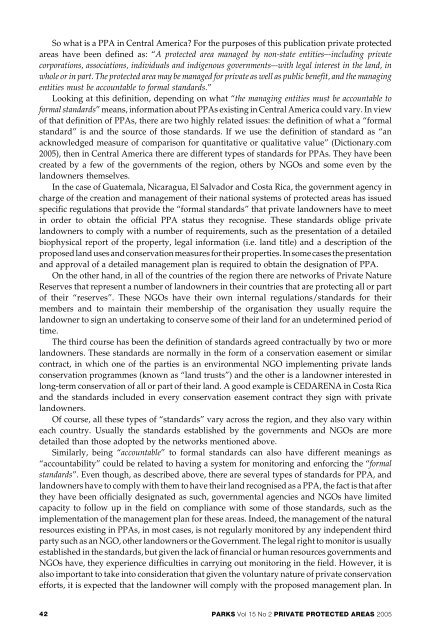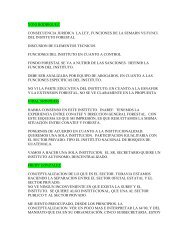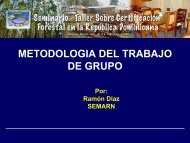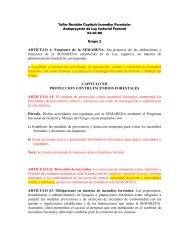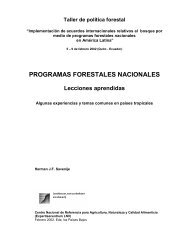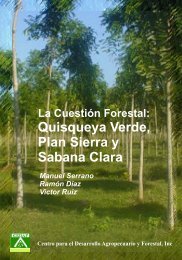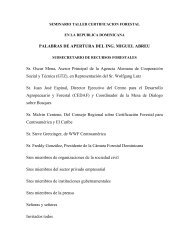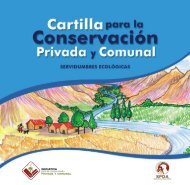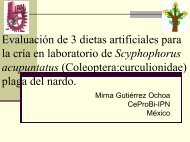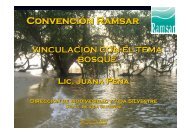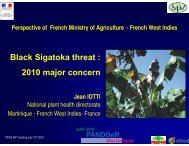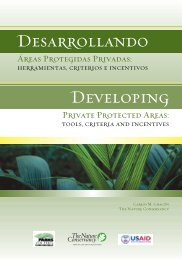Fostering conservation of key priority sites and rural ... - CEDAF
Fostering conservation of key priority sites and rural ... - CEDAF
Fostering conservation of key priority sites and rural ... - CEDAF
You also want an ePaper? Increase the reach of your titles
YUMPU automatically turns print PDFs into web optimized ePapers that Google loves.
So what is a PPA in Central America? For the purposes <strong>of</strong> this publication private protectedareas have been defined as: “A protected area managed by non-state entities–-including privatecorporations, associations, individuals <strong>and</strong> indigenous governments–-with legal interest in the l<strong>and</strong>, inwhole or in part. The protected area may be managed for private as well as public benefit, <strong>and</strong> the managingentities must be accountable to formal st<strong>and</strong>ards.”Looking at this definition, depending on what “the managing entities must be accountable t<strong>of</strong>ormal st<strong>and</strong>ards” means, information about PPAs existing in Central America could vary. In view<strong>of</strong> that definition <strong>of</strong> PPAs, there are two highly related issues: the definition <strong>of</strong> what a “formalst<strong>and</strong>ard” is <strong>and</strong> the source <strong>of</strong> those st<strong>and</strong>ards. If we use the definition <strong>of</strong> st<strong>and</strong>ard as “anacknowledged measure <strong>of</strong> comparison for quantitative or qualitative value” (Dictionary.com2005), then in Central America there are different types <strong>of</strong> st<strong>and</strong>ards for PPAs. They have beencreated by a few <strong>of</strong> the governments <strong>of</strong> the region, others by NGOs <strong>and</strong> some even by thel<strong>and</strong>owners themselves.In the case <strong>of</strong> Guatemala, Nicaragua, El Salvador <strong>and</strong> Costa Rica, the government agency incharge <strong>of</strong> the creation <strong>and</strong> management <strong>of</strong> their national systems <strong>of</strong> protected areas has issuedspecific regulations that provide the “formal st<strong>and</strong>ards” that private l<strong>and</strong>owners have to meetin order to obtain the <strong>of</strong>ficial PPA status they recognise. These st<strong>and</strong>ards oblige privatel<strong>and</strong>owners to comply with a number <strong>of</strong> requirements, such as the presentation <strong>of</strong> a detailedbiophysical report <strong>of</strong> the property, legal information (i.e. l<strong>and</strong> title) <strong>and</strong> a description <strong>of</strong> theproposed l<strong>and</strong> uses <strong>and</strong> <strong>conservation</strong> measures for their properties. In some cases the presentation<strong>and</strong> approval <strong>of</strong> a detailed management plan is required to obtain the designation <strong>of</strong> PPA.On the other h<strong>and</strong>, in all <strong>of</strong> the countries <strong>of</strong> the region there are networks <strong>of</strong> Private NatureReserves that represent a number <strong>of</strong> l<strong>and</strong>owners in their countries that are protecting all or part<strong>of</strong> their “reserves”. These NGOs have their own internal regulations/st<strong>and</strong>ards for theirmembers <strong>and</strong> to maintain their membership <strong>of</strong> the organisation they usually require thel<strong>and</strong>owner to sign an undertaking to conserve some <strong>of</strong> their l<strong>and</strong> for an undetermined period <strong>of</strong>time.The third course has been the definition <strong>of</strong> st<strong>and</strong>ards agreed contractually by two or morel<strong>and</strong>owners. These st<strong>and</strong>ards are normally in the form <strong>of</strong> a <strong>conservation</strong> easement or similarcontract, in which one <strong>of</strong> the parties is an environmental NGO implementing private l<strong>and</strong>s<strong>conservation</strong> programmes (known as “l<strong>and</strong> trusts”) <strong>and</strong> the other is a l<strong>and</strong>owner interested inlong-term <strong>conservation</strong> <strong>of</strong> all or part <strong>of</strong> their l<strong>and</strong>. A good example is CEDARENA in Costa Rica<strong>and</strong> the st<strong>and</strong>ards included in every <strong>conservation</strong> easement contract they sign with privatel<strong>and</strong>owners.Of course, all these types <strong>of</strong> “st<strong>and</strong>ards” vary across the region, <strong>and</strong> they also vary withineach country. Usually the st<strong>and</strong>ards established by the governments <strong>and</strong> NGOs are moredetailed than those adopted by the networks mentioned above.Similarly, being “accountable” to formal st<strong>and</strong>ards can also have different meanings as“accountability” could be related to having a system for monitoring <strong>and</strong> enforcing the “formalst<strong>and</strong>ards”. Even though, as described above, there are several types <strong>of</strong> st<strong>and</strong>ards for PPA, <strong>and</strong>l<strong>and</strong>owners have to comply with them to have their l<strong>and</strong> recognised as a PPA, the fact is that afterthey have been <strong>of</strong>ficially designated as such, governmental agencies <strong>and</strong> NGOs have limitedcapacity to follow up in the field on compliance with some <strong>of</strong> those st<strong>and</strong>ards, such as theimplementation <strong>of</strong> the management plan for these areas. Indeed, the management <strong>of</strong> the naturalresources existing in PPAs, in most cases, is not regularly monitored by any independent thirdparty such as an NGO, other l<strong>and</strong>owners or the Government. The legal right to monitor is usuallyestablished in the st<strong>and</strong>ards, but given the lack <strong>of</strong> financial or human resources governments <strong>and</strong>NGOs have, they experience difficulties in carrying out monitoring in the field. However, it isalso important to take into consideration that given the voluntary nature <strong>of</strong> private <strong>conservation</strong>efforts, it is expected that the l<strong>and</strong>owner will comply with the proposed management plan. In42 PARKS Vol 15 No 2 PRIVATE PROTECTED AREAS 2005


